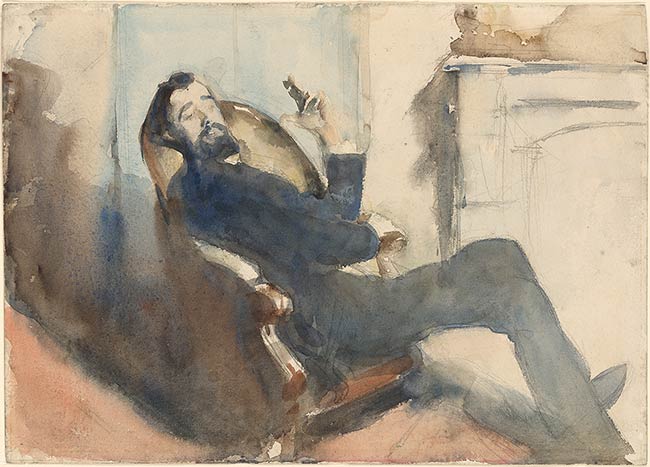
Sargent's drawing represents his close friend, the painter and printmaker Paul-César Helleu (1859-1927), whom he met in Paris about 1876 in a circle that included Edgar Degas and James McNeill Whistler. A former student of Jean-Leon Gerome, Helleu was struggling to establish himself as an artist when he and Sargent became friends. Sargent promoted Helleu's work and introduced him to potential clients. At the time of this portrait, Helleu's reputation was about to be launched with several large pastels he exhibited at the Salons of 1885 and 1886. He is best known today for his drypoint portraits of the Parisian beau-monde.
Sargent painted Helleu on several occasions--including "Paul Helleu Sketching with His Wife" in the Brooklyn Museum as well as other works on paper in oil, pastel, watercolor, and pencil. Two other portraits of Helleu, one a pencil drawing in the Metropolitan Museum of Art, New York (50.130.121), the other a pastel in the British Museum, London (1959.1.2.4), were framed together with the Morgan drawing in Sargent's home (Ormond and Kilmurray 1998, no. 92). The present drawing depicts Helleu sprawled comfortably in a low chair, a pose that emphasized his long thin legs and his "wiry and physical angularity" (Ormond and Kilmurray 1998, p. 93). He appears to hold a cigarette in his left hand, and his mouth is open slightly as though Sargent has caught him in mid-sentence. The drawing, begun with a quick pencil sketch and finished with broad strokes of the watercolor brush, has great immediacy and surely was executed on the spot.
Label description: The French painter and etcher Paul-César Helleu was one of Sargent's closest friends. They likely met in 1876, as both dined with Claude Monet in April of that year. Sargent sketched his friend several times, finding pictorial inspiration in Helleu's angular physique. Here he captured Helleu sprawled on a low chair, with one hand raised as if in the act of speaking. Sargent began with a quick pencil sketch and then finished the portrait with washes of watercolor. Later in his life, as he turned from portraiture to landscape, he used watercolor more frequently for its ability to capture the fleeting effects of light. -- Exhibition Label, from "John Singer Sargent: Portraits in Charcoal"
Richard Ormond and Elaine Kilmurray, "John Singer Sargent: Complete Paintings, I, The Early Portraits," New Haven and London, 1998, no. 92, repr. in color.
